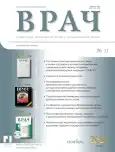Нейропластичность при применении аналога человеческого глюкагоноподобного пептида-1 у пациента с ожирением: клинический случай
- Авторы: Матвеева М.В.1, Самойлова Ю.Г.1, Олейник О.А.1, Кудлай Д.А.2,3, Подчиненова Д.В.1, Апальков Д.Г.1
-
Учреждения:
- Сибирский государственный медицинский университет Минздрава России
- Первый МГМУ им. И.М. Сеченова Минздрава России (Сеченовский Университет)
- Московский государственный университет им. М.В. Ломоносова
- Выпуск: Том 34, № 11 (2023)
- Страницы: 75-78
- Раздел: Из практики
- URL: https://journals.eco-vector.com/0236-3054/article/view/624413
- DOI: https://doi.org/10.29296/25877305-2023-11-18
- ID: 624413
Цитировать
Полный текст
Аннотация
Представленный клинический случай отражает разнообразие симптомов при ожирении с вовлечением центральной нервной системы. При этом применение лираглутида у пациента с ожирением привело не только к снижению площади висцерального жира, но и улучшению когнитивных функций, снижению нейропилина, и, как следствие, обратимости нейрометаболизма и функциональных изменений головного мозга. Для сопоставления результатов использовались источники литературы из международных и российских баз данных за 5 лет.
Ключевые слова
Полный текст
Об авторах
М. В. Матвеева
Сибирский государственный медицинский университет Минздрава России
Email: oleynikoa@mail.ru
ORCID iD: 0000-0001-9966-6686
доктор медицинских наук, профессор
Россия, ТомскЮ. Г. Самойлова
Сибирский государственный медицинский университет Минздрава России
Email: oleynikoa@mail.ru
ORCID iD: 0000-0002-2667-4842
доктор медицинских наук, профессор
Россия, ТомскО. А. Олейник
Сибирский государственный медицинский университет Минздрава России
Email: oleynikoa@mail.ru
ORCID iD: 0000-0002-2915-384X
кандидат медицинских наук
Россия, ТомскД. А. Кудлай
Первый МГМУ им. И.М. Сеченова Минздрава России (Сеченовский Университет); Московский государственный университет им. М.В. Ломоносова
Email: oleynikoa@mail.ru
ORCID iD: 0000-0003-1878-4467
член-корреспондент РАН, доктор медицинских наук, профессор
Россия, Москва; МоскваД. В. Подчиненова
Сибирский государственный медицинский университет Минздрава России
Автор, ответственный за переписку.
Email: oleynikoa@mail.ru
ORCID iD: 0000-0001-6212-4568
кандидат медицинских наук
Россия, ТомскД. Г. Апальков
Сибирский государственный медицинский университет Минздрава России
Email: oleynikoa@mail.ru
Россия, Томск
Список литературы
- Mayoral L.P., Andrade G.M., Mayoral E.P. et al. Obesity subtypes, related biomarkers & heterogeneity. Indian J Med Res. 2020; 151 (1): 11–21. doi: 10.4103/ijmr.IJMR_1768_17
- Hruby A., Hu F.B. The Epidemiology of Obesity: A Big Picture. Pharmacoeconomics. 2015; 33 (7): 673–89. doi: 10.1007/s40273-014-0243-x
- Ortega F.B., Mora-Gonzalez J., Cadenas-Sanchez C. et al. Effects of an Exercise Program on Brain Health Outcomes for Children With Overweight or Obesity: The ActiveBrains Randomized Clinical Trial. JAMA Netw Open. 2022; 5 (8): e2227893. doi: 10.1001/jamanetworkopen.2022.27893
- Selman A., Burns S., Reddy A.P. et al. The Role of Obesity and Diabetes in Dementia. Int J Mol Sci. 2022; 23 (16): 9267. doi: 10.3390/ijms23169267
- Benomar Y., Taouis M. Molecular Mechanisms Underlying Obesity-Induced Hypothalamic Inflammation and Insulin Resistance: Pivotal Role of Resistin/TLR4 Pathways. Front Endocrinol (Lausanne). 2019; 10: 140. doi: 10.3389/fendo.2019.00140
- Flores-Cordero J.A., Pérez-Pérez A., Jiménez-Cortegana C. et al. Obesity as a Risk Factor for Dementia and Alzheimer's Disease: The Role of Leptin. Int J Mol Sci. 2022; 23 (9): 5202. doi: 10.3390/ijms23095202
- Cui Q.N., Stein L.M., Fortin S.M. et al. The role of glia in the physiology and pharmacology of glucagon-like peptide-1: implications for obesity, diabetes, neurodegeneration and glaucoma. Br J Pharmacol. 2022; 179 (4): 715–26. doi: 10.1111/bph.15683
- Nakanishi Y., Kang S., Kumanogoh A. Axon guidance molecules in immunometabolic diseases. Inflamm Regen. 2022; 42 (1): 5. doi: 10.1186/s41232-021-00189-0
- Al-Thomali A.W., Al-Kuraishy H.M., Al-Gareeb A.I. et al. Role of Neuropilin 1 in COVID-19 Patients with Acute Ischemic Stroke. Biomedicines. 2022; 10 (8): 2032. doi: 10.3390/biomedicines10082032
- Дедов И.И., Шестакова М.В., Мельниченко Г.А. и др. Междисциплинарные клинические рекомендации «Лечение ожирения и коморбидных заболеваний». Ожирение и метаболизм. 2021; 18 (1): 5–99 [Dedov I.I., Shestakova M.V., Melnichenko G.A. et al. Interdisciplinary clinical practice guidelines "Management of obesity and its comorbidities". Obesity and metabolism. 2021; 18 (1): 5–99 (in Russ.)]. doi: 10.14341/omet12714
- Caballero B. Humans against Obesity: Who Will Win? Adv Nutr. 2019; 10 (suppl_1): S4–S9. doi: 10.1093/advances/nmy055
- Melchior V., Fuchs S., Scantamburlo G. Vignette thérapeutique de l’étudiant. Obésité et troubles du comportement alimentaire [Obesity and eating disorders]. Rev Med Liege. 2021; 76 (2): 134–9 (in French).
- Ho Y.C., Srinivasan R.S. Lymphatic Vasculature in Energy Homeostasis and Obesity. Front Physiol. 2020; 11: 3. doi: 10.3389/fphys.2020.00003
- Song S., Guo R., Mehmood A. et al. Liraglutide attenuate central nervous inflammation and demyelination through AMPK and pyroptosis-related NLRP3 pathway. CNS Neurosci Ther. 2022; 28 (3): 422–34. doi: 10.1111/cns.13791
- Drucker D.J. GLP-1 physiology informs the pharmacotherapy of obesity. Mol Metab. 2022; 57: 101351. doi: 10.1016/j.molmet.2021.101351
- Knudsen L.B., Lau J. The Discovery and Development of Liraglutide and Semaglutide. Front Endocrinol (Lausanne). 2019; 10: 155. doi: 10.3389/fendo.2019.00155
- Varkevisser R.D.M., van Stralen M.M., Kroeze W. et al. Determinants of weight loss maintenance: a systematic review. Obes Rev. 2019; 20 (2): 171–211. doi: 10.1111/obr.12772
- Val-Laillet D., Aarts E., Weber B. et al. Neuroimaging and neuromodulation approaches to study eating behavior and prevent and treat eating disorders and obesity. Neuroimage Clin. 2015; 8: 1–31. doi: 10.1016/j.nicl.2015.03.016
Дополнительные файлы







